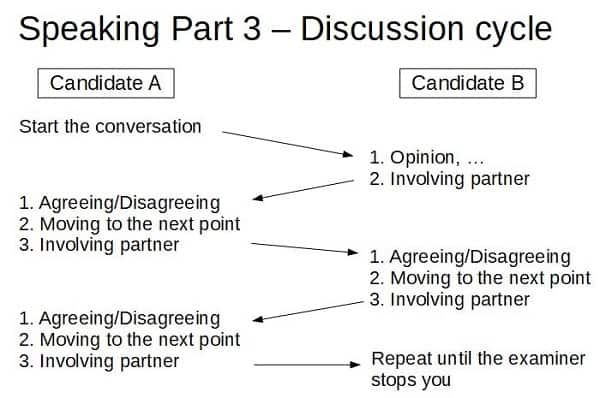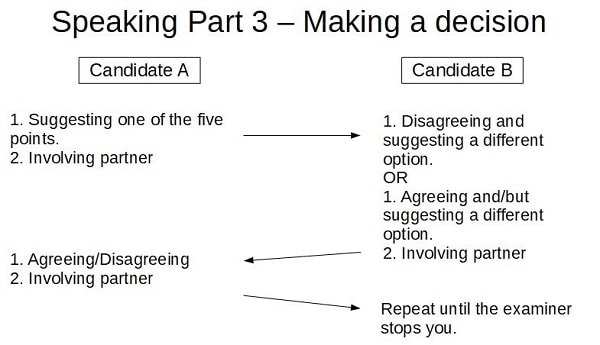How does the FCE Speaking Exam Part 3 work?
In this part of the test you and your partner will talk together. The interlocutor will place a new set of pictures on the table between you for you to discuss together.
- Be prepared to ask your partner for his or her opinion rather than simply stating your own. For example:
‘What do you think?’ ‘How about you?’ ‘Do you think …?’ - Listen carefully to what your partner says and respond to comments he or she makes to help the discussion flow. For example:
‘Do/Have/Are you?’ ‘Don’t/Haven’t/Aren’t you?’ ‘Do you think so? ‘Really?’ - If you disagree try expressing this politely. For example:
‘I see what you mean but …’ ‘I can see your point but …’ ‘But don’t you think …’ - Use expressions to allow yourself time to think. For example:
‘That’s a good question.’ ‘Well, let me think …’ ‘It’s difficult to say …’ - You’ll possibly find you don’t understand something your partner has said. If this happens, take control with simple questions like those below to help you deal positively with the situation. This will also give you the chance to impress the examiner with your communication skills.
A) If you didn’t quite understand a word or phrase just say something like:
“Sorry but could you explain what you mean by ……..” or
“I haven’t come across that word/expression before. Could you explain what you mean?”
B) If you didn’t hear or didn’t understand something your partner has said, ask them to repeat it:
“Sorry, I didn’t catch that. Could you say that again?”
“Excuse me. Could you repeat that?”
C) Alternatively, you might want to confirm what you think your partner said so you could say something like:
“Do you mean ……..”
“When you say …….., are you asking/do you mean ……..?”
In this post you will find more useful phrases that you can use in your Speaking Exam.
The Best Strategy for FCE Speaking Exam Part 3
Speaking Part 3 has two sections and for each one you should follow a different plan. Luckily, this plan can be used every time you practise as well as in the exam itself, so here you are the best strategies you can use for each of them.
Section 1
In the discussion part you should mostly focus on well structured answers, good language and interaction with your partner. It follows a cycle that you go through together until the examiner stops you after about two minutes. This cycle looks something like this:

You can see that it is a back and forth between you and your partner and it always follows the same structure. You agree or disagree, you give your opinion (always give reasons and examples to support your argument) and you invite the other candidate back into the conversation. You do this until the two minutes are up and the examiner asks you to stop.
Section 2
The second section of Speaking Part 3 is different from the first one in a couple of ways. Number one, you have only one minute and number two, you have to decide something with your partner instead of discussing the question in the spiderweb. It is very important for you to have the right strategy in order to balance your talking time and to work towards a decision.
Just as before, however, there is a model that you can and should use:

It always works the same. Candidate A starts by suggesting one of the five prompts giving reasons for his/her answer. The next step is the most important part. Candidate B has to suggest another option because if you simply agree, there won’t be anything left to talk about. The problem is that you need to speak until the examiner stops you.
For this reason, Candidate B always offers another option so that you can choose between two of the points. This way, you can talk to each other for the full minute using some nice language (keep reading below for good examples) and interacting with each other.
REMEMBER!
DO discuss each of the prompts in detail. It doesn’t matter if you don’t talk about all of them.
DO listen to your partner and respond to what he/she has to say before adding your own ideas.
DO invite your partner to respond and/or contribute – remember, it should be a conversation between
the two of you!
DON’T worry if you don’t come to an agreement with your partner. The important part is discussing
and sharing your opinion!
DON’T dominate the conversation – be sure your partner gets a chance to speak as well.
If this sounds very messy, don’t worry because now you can check out one real-life example so you can see exactly how it works. Hope you find this information useful!



Comments are closed